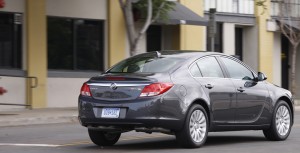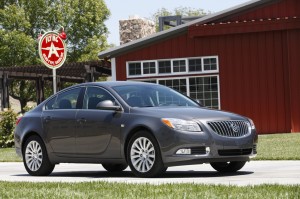
The Buick Regal was supposed to be the next Saturn Aura. Instead, it becomes an Acura TSX-fighting Buick.
Isn’t this what Buick always should have been, or at least could have been? Instead General Motors was content to build a series of velour-encrusted boulevardiers, content with the 60-and-over set, never offering anything that a young professional would even consider.
Buick’s new Regal promises to single-handledly bring the marquee’s average age down by decades. It finally gives General Motors a legitimate competitor for such small near-luxury cars as Acura TSX and Audi A4.
There’s a lot to like here. Even though this car started life as the acclaimed Opel Insignia, and GM initially planned to sell it as the second-generation Saturn Aura, it actually fits right in as a Buick. With just changes to details such as the grille and lights, the Opel gives Buick a perfect entry in what is sure to a burgeoning category in coming years.
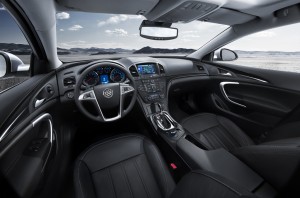
The Regal's interior is covered in expensive-looking soft-touch materials, but the lighting scheme needs some work.
The interior is full of expensive-looking soft-touch materials and it has a dynamic, fluid design. It sort of looks like a Europeanized and slightly smaller version of big brother LaCrosse’s superb interior.
It also drives well. The suspension is sharp without giving the car a rough ride. The steering is communicative and nicely weighted. There’s just a bit of torque steer, surprising since there really isn’t much power here.
Which brings us to the Regal’s biggest demerit: its engine. While GM’s 2.4-liter four cylinder is familiar and well traveled throughout GM’s lineup, it doesn’t work well here. With just 182 horsepower, the Regal feels like it’s short at least 25 horsepower. An optional 220-horsepower version of GM’s turbocharged 2.0-liter engine is now available.
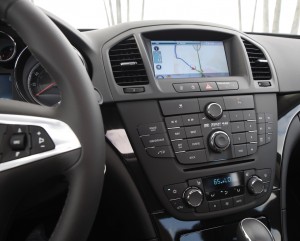
The Regal's interior has a European look to it, not surprising, since it started life as the Opel Insignia.
And if 220 horses isn’t enough, wait for the the Regal GS which goes on sale in 2012 with a 255-horsepower version of the 2.0-liter turbo engine.
Regular Regals come with a six-speed automatic transmission, but a six-speed manual is available with the turbo, the first Buick with a third pedal in more than 20 years.
The lack of punch from the standard engine is noticeable. If rest of the car feels so right, the engine feels like it is holding the rest of it back.
Fuel mileage isn’t even the positive one would expect with such limited power. It’s rated at 19 city and 30 highway. That city number is surprisingly low for an automaker that has done very well throwing up big numbers in the EPA’s fuel economy tests.
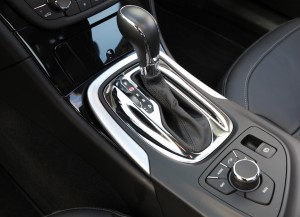
The Regal features a knob behind the gearshift that can be used to adjust the radio and navigation system.
Besides the lack of power, the engine tuning is strange. It feels rough, not the feeling you want in a near-luxury car. It’s an odd sensation because the same complaints aren’t present in other applications of this engine such as the GMC Terrain and Chevrolet Equinox. It could be a matter of expectations.
It also sounds like a farm implement. It’s possible that because the Regal was handed to Buick so late in the process that the engineers didn’t have enough time to tune the engine, exhaust and structure so it would sound like a proper Buick.
This seems to be a critical problem for the Regal because its competitors have silky smooth fours delivering more power. Consider the TSX, which has a standard 201-horsepower 2.4-liter engine, yet is rated at 22 city and 31 highway.
The tuning of the six-speed automatic transmission also comes in for a little criticism. Auto shifts are slow, manumatic shifts not much better. And ask for a gear that falls outside of the allowable range for that gear and the Regal’s instrument panel screen flashes “Shift denied.”
Inside, the Regal is mostly a pleasure, but there are still some niggling issues.
First, the positives. The Regal’s seats are readily comfortable. The interior isn’t very wide, so the center console is fairly narrow. Front-seat passengers tend to bump elbows. There’s room for two in back, but the slopping roof tends to cut into headroom. Knee and foot room are decent.
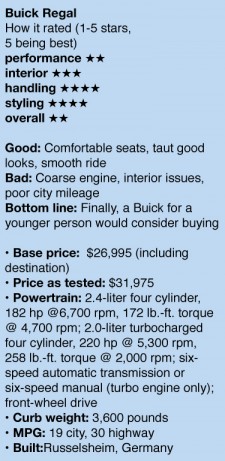 As is the case with many of GM’s European products, some elements of the infotainment system are rather convoluted. GM has farmed much of its car engineering and design to its Korean, Chinese and European affiliates, but the home office needs to rethink the audio controls the foreign offices send this way.
As is the case with many of GM’s European products, some elements of the infotainment system are rather convoluted. GM has farmed much of its car engineering and design to its Korean, Chinese and European affiliates, but the home office needs to rethink the audio controls the foreign offices send this way.
Also up for a little rethinking, is the Regal’s lighting scheme. Dim the lights at night and you’ll have to pump them back up at during the day if you have any interest in seeing the center console display. And no matter how much you dim the interior lights, the indicator for the gearshift always shines brightly enough to incite jealousy from a lighthouse. You could always put a piece of electrical tape over it.
The Regal starts at $26,995, including destination. Options including metallic paint ($195) and comfort and convenience package costing a knee-buckling $4,795 brings the price to $31,975.
GM has hit quite a few doubles, triples and even a couple of home runs in recent years. But the Regal is a bunt single. A few key improvements would help Buick get this one out of the infield.

